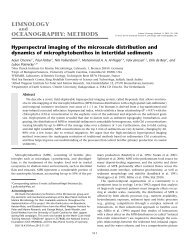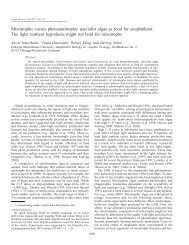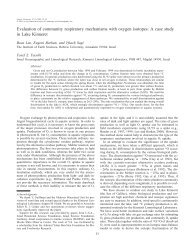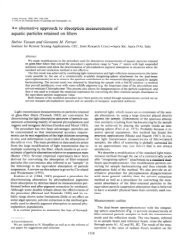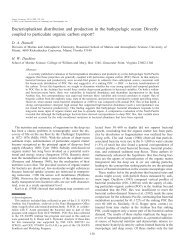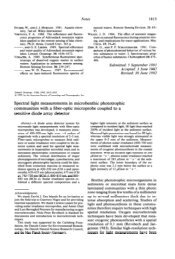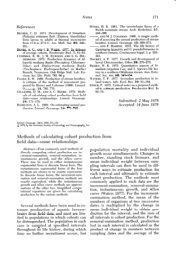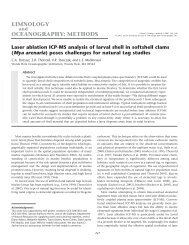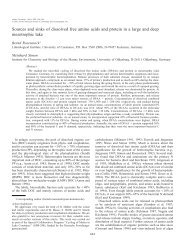Tina van de Flierdt, Katharina Pahnke, and GEOTRACES ... - ASLO
Tina van de Flierdt, Katharina Pahnke, and GEOTRACES ... - ASLO
Tina van de Flierdt, Katharina Pahnke, and GEOTRACES ... - ASLO
You also want an ePaper? Increase the reach of your titles
YUMPU automatically turns print PDFs into web optimized ePapers that Google loves.
<strong>van</strong> <strong>de</strong> <strong>Flierdt</strong> et al. Seawater Nd Isotopes: Intercalibration<br />
all other laboratories (Table 1b). A similarly good result is however<br />
obtained by Laboratory 10, for the <strong>de</strong>ep water samples<br />
where results agree within 3% RSD with the average values.<br />
Laboratories 1, 5, <strong>and</strong> 16 show <strong>de</strong>viations from the average<br />
within 6% to 8% for both water <strong>de</strong>pths, <strong>and</strong> Laboratory 8 is<br />
just outsi<strong>de</strong> this margin with agreements within 10% to 13%<br />
(RSDs cited inclu<strong>de</strong> all REE but Ce).<br />
How good is the observed agreement? Taking into account<br />
that most individual laboratories quote external errors for<br />
their methodologies well below 10%, it might be expected<br />
that an agreement within 10% should be possible. The<br />
observed agreement is not far from this number, <strong>and</strong> data<br />
returns on an unknown REE st<strong>and</strong>ard solution sent to the<br />
individual laboratories did not yield an improved agreement<br />
over natural samples (Table 7; Fig. 6). The last statement is<br />
based on comparison of results from Laboratories 1 <strong>and</strong> 8,<br />
which show an agreement within 10% for most REE, <strong>and</strong> 16%<br />
for all REE (relative 2s SD).<br />
REE concentrations reported by Lab 17 (not shown in Fig.<br />
5) are significantly lower than results obtained by other laboratories<br />
(~30% to 70%). Looking into the <strong>de</strong>tail of the methodology<br />
applied by this laboratory (Table 1b), a number of factors<br />
could be responsible for this offset. First, the laboratory<br />
did not spike their concentration samples, which means that<br />
imperfect yields <strong>and</strong> fractionation of REE during preconcentration<br />
<strong>and</strong> ion chromatography cannot be corrected for. Second,<br />
the laboratory used the REE cut from their Nd isotope<br />
chemistry to <strong>de</strong>termine REE concentrations, which again<br />
stresses that sample recovery up to this point had to be<br />
assumed (i.e., 100% yield). Finally, calculations of REE contents<br />
were based on the assumption that the starting sample<br />
volume was 10 L, without, however, <strong>de</strong>termining the exact<br />
weight before Fe coprecipitation. Shipboard sampling easily<br />
introduces an error of 10% on this assumption, as no efforts<br />
were un<strong>de</strong>rtaken to collect exact sample volumes. The most<br />
likely explanation for the <strong>de</strong>viation of Laboratory 17 from the<br />
average result is therefore a combination of unaccounted sample<br />
loss, <strong>and</strong> an erroneous assumption on sample volume. It is<br />
notable that the laboratory significantly improved their<br />
methodology for the analysis of the unknown st<strong>and</strong>ard. However,<br />
the <strong>de</strong>viation from the average of the two other laboratories<br />
is still 11% to 22%. Further improvement can probably<br />
be achieved through close exchange with one of the other laboratories<br />
<strong>and</strong> improved spike calibration.<br />
A better statistical database for evaluating reproducibility of<br />
individual REE concentrations can be achieved when consi<strong>de</strong>ring<br />
Nd concentrations only. Besi<strong>de</strong>s the seven laboratories<br />
that reported full REE pattern for seawater at BATS, three additional<br />
laboratories spiked their large volume isotope samples<br />
to <strong>de</strong>termine Nd concentrations (Laboratories 2, 6, 12), <strong>and</strong><br />
two other laboratory (9 <strong>and</strong> 11) obtained separate 0.25 to 0.5<br />
L aliquots for Nd concentration measurements (Table 6).<br />
Results for Nd concentrations from all 11 laboratories (omitting<br />
Laboratory 17) are shown in Fig. 7 for the two intercali-<br />
248<br />
Fig. 6. REE concentrations for an unknown st<strong>and</strong>ard solution. Results<br />
reported by three laboratories on a pure REE st<strong>and</strong>ard solution that was<br />
mixed to roughly match seawater concentrations. The st<strong>and</strong>ard was sent<br />
around with the information that concentrations for Ce are approximately<br />
10 ppm, <strong>and</strong> that dilutions for analyses should be carried out accordingly.<br />
Laboratories 1 <strong>and</strong> 8 show good agreement, whereas laboratory 17 (not<br />
shown in Fig. 5) <strong>de</strong>viates significantly from the average value.<br />
Fig. 7. Dissolved neodymium concentrations at BATS. Neodymium concentrations<br />
were not only analyzed by the laboratories interested in REE<br />
concentration analyses, but also by some laboratories that are primarily<br />
interested in Nd isotopic compositions. Eleven laboratories (omitting laboratory<br />
17) show an agreement of Nd concentrations for two different<br />
water samples within 9%, reflecting the precision currently possible on<br />
REE concentration measurements. Error bars reflect external errors (not<br />
reported by every laboratory; see Table 6). The average value <strong>and</strong> its two<br />
sigma st<strong>and</strong>ard <strong>de</strong>viation have been calculated from the mean values for<br />
each laboratory in or<strong>de</strong>r to not weigh the average toward results from<br />
laboratories that report larger amounts of individual analyses. For comparison,<br />
Table 6 shows the statistics when calculating the average from all<br />
individual data points reported.<br />
bration water <strong>de</strong>pths at BATS. Shallow waters yield a Nd concentration<br />
of 2.0 ± 0.2 ng/kg, <strong>and</strong> <strong>de</strong>ep waters are slightly<br />
more concentrated at 2.5 ± 0.2 ng/kg. Errors are absolute two<br />
sigma st<strong>and</strong>ard <strong>de</strong>viations from the mean of all data, which<br />
translate to 9% <strong>and</strong> 7% RSD, respectively. This result confirms<br />
that a 10% envelope is probably the best agreement currently<br />
possible for REE analyses between different laboratories.




